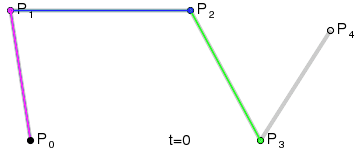
Credit: Phil Tregoning
A Bézier curve is a parametric curve important in computer graphics and related fields.
Widely publicized in 1962 by the French engineer Pierre Bézier, who used them to design automobile bodies, the curves were first developed in 1959 by Paul de Casteljau using de Casteljau's algorithm. In this animation, a quartic Bézier curve is constructed using control points P0 through P4. The green line segments join points moving at a constant rate from one control point to the next; the parameter t shows the progress over time. Meanwhile, the blue line segments join points moving in a similar manner along the green segments, and the magenta line segment points along the blue segments. Finally, the black point moves at a constant rate along the magenta line segment, tracing out the final curve in red. The curve is a fourth-degree function of its parameter. Quadratic and cubic Bézier curves are most common since higher-degree curves are more computationally costly to evaluate. When more complex shapes are needed, lower-order Bézier curves are patched together. For example, modern computer fonts use Bézier splines composed of quadratic or cubic Bézier curves to create scalable typefaces. The curves are also used in computer animation and video games to plot smooth paths of motion. Approximate Bézier curves can be generated in the "real world" using string art.